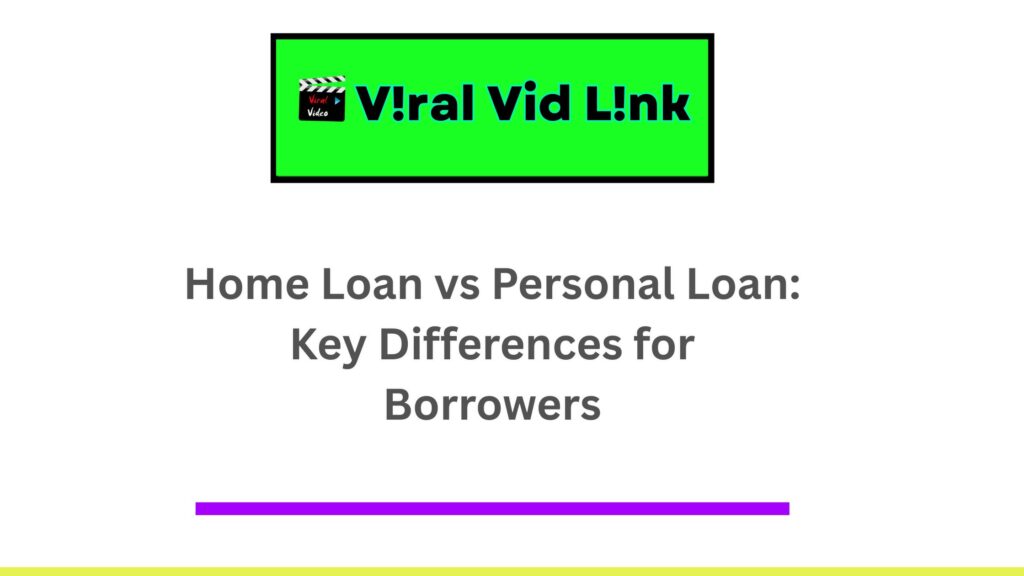
Whether you’re planning to buy a dream home or fund a major expense, understanding the differences between a home loan and a personal loan is crucial.
This guide breaks down their features, benefits, and ideal use cases to help you make informed decisions aligned with your financial goals.
Understanding Home Loans and Personal Loans in 2025
Before diving into comparisons, let’s clarify what these loans entail:
What Is a Home Loan?
A home loan is a secured loan designed specifically for purchasing, constructing, or renovating residential or commercial property.
The property itself acts as collateral, which means the lender can claim ownership if you default on payments. These loans typically offer lower interest rates and longer repayment tenures (up to 30 years).
What Is a Personal Loan?
A personal loan is an unsecured loan that can be used for almost any purpose—weddings, medical emergencies, travel, or debt consolidation. Since no collateral is required, lenders rely heavily on your credit score and income to approve the loan. Interest rates are higher, and repayment periods are shorter (usually 1–7 years).
Key Differences Between Home Loans and Personal Loans
Let’s explore the factors that set these loans apart in 2025’s financial landscape:
1. Purpose of the Loan
Home Loan: Exclusively for property-related expenses. Lenders may even disburse funds directly to the seller or builder.
Personal Loan: Flexible usage, from funding vacations to covering unexpected bills. No need to explain how you’ll spend the money.
2. Interest Rates and Tenure
Home Loan: Enjoy lower interest rates (6–9% in 2025) due to secured nature. Repayment can span decades, easing monthly burdens.
Personal Loan: Higher rates (10–24%) compensate for the lender’s risk. Shorter tenures mean larger EMIs but quicker debt clearance.
3. Collateral Requirements
Home Loan: Requires collateral (the property). Defaulting risks losing the asset.
Personal Loan: No collateral needed, making approval faster but riskier for lenders.
4. Tax Benefits
Home Loan: Tax deductions under Sections 24(b) and 80C for interest and principal repayments.
Personal Loan: No tax benefits unless used for business or home renovation (specific conditions apply).
5. Loan Amount and Eligibility
Home Loan: Amounts depend on property value, income, and credit score. Lenders may finance up to 80–90% of the property’s cost.
Personal Loan: Typically capped at ₹25–50 lakhs, based on income and creditworthiness.
Which Loan Should You Choose in 2025?
Your decision hinges on three factors:
- Financial Goal:
- Opt for a home loan if buying property. Lower rates and tax perks make it cost-effective.
- Choose a personal loan for immediate, short-term needs like education or emergencies.
- Repayment Capacity:
- Home loans spread payments over decades, ideal for stable, long-term income.
- Personal loans demand higher EMIs, suitable for those with surplus monthly cash flow.
- Credit Profile:
- A high credit score (750+) secures better terms for both loans. However, personal loans are stricter due to their unsecured nature.
Trends Impacting Loans in 2025
Stay ahead with these developments shaping borrowing this year:
- Digital Loan Processing: AI-driven approvals and e-KYC reduce processing time to hours.
- Green Home Loans: Discounted rates for eco-friendly homes or energy-efficient upgrades.
- Dynamic Interest Rates: Floating-rate home loans adjust to market trends, potentially saving money if rates drop.
FAQs: Home Loan vs Personal Loan
1. Can I use a personal loan for a home down payment?
Yes, but it’s risky. Personal loans have higher EMIs, which could strain your budget alongside a home loan.
2. Which loan is cheaper in the long run?
Home loans cost less due to lower rates and tax benefits. Personal loans are pricier but offer flexibility.
3. How does my credit score affect these loans?
A high score (750+) secures lower rates for both. For personal loans, it’s critical for approval.
4. Are prepayment penalties applicable?
Home loans may have prepayment charges on floating rates. Personal loans usually allow free prepayment.
5. Can I convert a personal loan into a home loan?
No. However, you can use a balance transfer to shift high-interest personal debt to a lower-rate loan.
Smart Borrowing Tips for 2025
- Compare Lenders: Use online tools to check rates, processing fees, and customer reviews.
- Plan for Contingencies: Ensure you have emergency savings before committing to long-term debt.
- Leverage Government Schemes: First-time homebuyers can benefit from subsidies like PMAY (Pradhan Mantri Awas Yojana).
Final Thoughts
Choosing between a home loan and a personal loan in 2025 depends on your financial priorities and discipline. Home loans are unbeatable for property investments, while personal loans offer quick liquidity for life’s uncertainties.
By aligning your choice with current economic trends and your repayment capacity, you can borrow wisely and stay financially secure.


